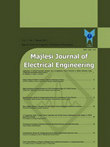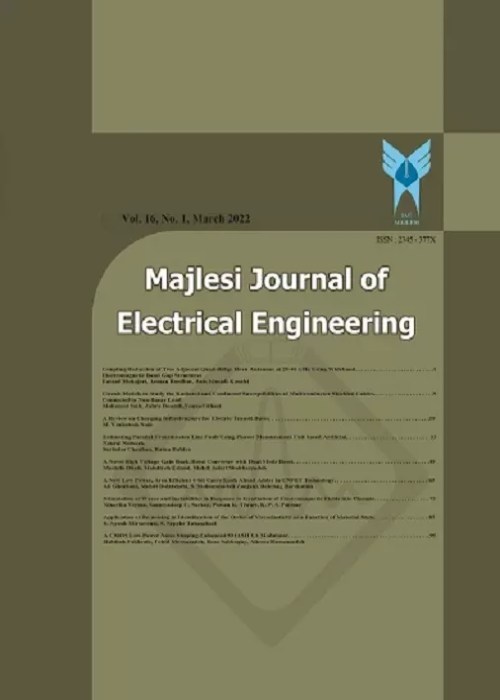فهرست مطالب

Majlesi Journal of Electrical Engineering
Volume:12 Issue: 3, Sep 2018
- تاریخ انتشار: 1397/06/14
- تعداد عناوین: 10
-
-
Pages 1-9This paper proposes a new Space Vector Modulation (SVM) technique to control the grid-side inverter for improving the output power quality of a Doubly-Fed Induction Generator (DFIG) based Wind Energy Conversion System (WECS). A five-level Cascaded H-Bridge Inverter (CHBI) was used to connect the DFIG to the grid. The SVM algorithm enables controlling of the DFIG inverter which improves the quality of the output power by reducing the Total Harmonic Distortion (THD) of the generated currents and power ripples. However, the multi-level inverter has a major drawback, the even-order harmonics production, which can be overcame by controlling the five-level CHBI using this novel SVM technique generalized to N-level. The paper further presents the mechanism of this algorithm and a method to deduce the trajectories from the sequences, enabling reduction of the time and number of commutations, a better performance among several possible trajectories, and reduction of the THD rate of the DFIG output currents.Keywords: Wind Energy Conversion System, Doubly-Fed Induction Generator, Space Vector Modulation, Total Harmonic Distortion
-
Pages 11-22The concentration of data transfer towards the sink in a wireless sensor network causes the nearby nodes to exhaust their batteries faster than other nodes, which leaves the sink trapped and disrupts the data reporting by sensor nodes to each other. To avoid such scenarios, protocols with mobile sinks was proposed. It helped in achieving load balancing and uniform energy consumption throughout the network. We tried to concentrate on the dynamic requirements of mobile sink. We have provided an overview of the concerns of a mobile sink routing protocol, design requirements and challenges associated with the problem of mobile sink routing. Along with it, we explained the types of mobile sink protocols and compared them on the basis of some important parameters that define a protocol. In this paper, the concept of mobile sink is proposed with various protocols that were defined with static sink. Mobile sink is supposed to be moving in each round and data collection is done through Coordinator cluster head (CCH) which collects the data through various cluster heads (CH). Simulation result showed that mobile sink concept is increasing the network lifetime.Keywords: Mobile Sinks, Distributed Routing, Wireless Sensor Networks
-
Pages 23-34In this paper, a novel circuit for memristor based Infinite Impulse Response Filter (IIR) filter implementation is presented. In this research for increasing the input voltage range in sampling the analog signal, complementary switches were used instead of single-transistor switches. In addition, to increase the filter accuracy, a delayed circuit with the ability to implement high-order filters is presented. In this work, coefficients of the IIR filter were implemented by memristor; using such component could provide in-system reconfigurability. The memristor could decline receiving negative values, where IIR filter coefficients have negative values. In this research a new method for generating negative numbers as filter coefficients is presented. During running an advanced search algorithm, the memristor values were set at six, seven, and eight bits of resolution; these values cause memristors have the lowest error rate in generating coefficients. All circuits were simulated by Cadence tools on TSMC 0.18 micrometer technology platform with 1.8 volt power supply. In simulation results, outputs of low/high-pass filters along with the error rate of coefficients calculated and compared to actual coefficients.Keywords: Delay circuit, Generating negative coefficients, IIR filter, Memristor, Sampling circuit
-
Pages 35-40Quantum Cellular Automata (QCA) is one of the main substitutes for CMOS technology and it is used in implementation of different systems. Manifest features including high speed and low power consumption increase the subject of the QCA in research. However, the extensive possibility of occurrence of defects and appropriate physical implementation in the QCA is one of fundamental challenges in using such technology. In this study, basic details about nanotechnology and related discussions to the fault tolerant in this field are presented. In addition, by investigation on several XOR gates, two novel XOR gates are proposed, these gates were designed by using fault tolerance tile structures. Afterwards, for determining the optimum gate, the tolerance rate of these gates against missing cell defects were investigated. Simulation results showed that proposed gates have more tolerance against missing cell defects.Keywords: Quantum Cellular Automata, Fault tolerant, XOR gate, Tile structure, Nano electronic
-
Pages 41-53The weakness of the Direct Vector Control (DVC) is lack of an estimation of the flux amplitude and the rotor position with high accuracy. These quantities are sensitive to parameter variations; it is important to use a robust estimation system for estimating the rotor flux with respect to parametric uncertainties. In this paper the sliding mode speed sensorless vector control based on the Model Reference Adaptive System (MRAS) of double stator induction motor is presented. First, the models of the double stator induction motor and the DVC are proposed. Second, the MRAS technique of the DSIM (Double Stator Induction Motor) is adopted. In order to ensure a robust sensorless control, the sliding mode technique for the estimation system was used. The results showed the presented estimator has a positive effect on the system behavior especially in changing the reference and/or the parameters variation.Keywords: Double Stator Induction Motor, Direct Field Oriented Control, Model Reference Adaptive System, Sliding Mode Control, Sensorless Control
-
Pages 55-59This paper presents a Direct Torque Control (DTC) strategy for the Permanent Magnets Synchronous Machine (PMSM). The principle relies on a Space Vector Modulation (SVM) technique that uses hysteresis comparators for the determination of the voltage module and angle, the proposed control method is simple to implement. It allows reducing the fluctuations level of the torque and the flux in low speed conditions. Contrary to the classical DTC technique, the proposed approach is able to handle and to control the switching frequency even for driving the motor with a low speed as a reference. Simulations results were obtained and allowed demonstrating better performance of this command especially in the behavior of the couple and the flux.Keywords: Permanent Magnet Synchronous Machine (PMSM), DTC, SVM, Voltage inverter, PWM
-
Pages 61-65Handwritten digit recognition has got a special role in different applications in the field of digital recognition including; handwritten address detection, check, and document. Persian handwritten digits classification has been facing difficulties due to different handwritten styles, inter-class similarities, and intra-class differences. In this paper, a novel method for detecting Persian handwritten digits is presented. In the proposed method, a combination of Histogram of Oriented Gradients (HOG), 4-side profiles of the digit image, and some horizontal and vertical samples was used and the dimension of the feature vector was reduced using Principal Component Analysis (PCA). The proposed method applied to the HODA database, and Support Vector Machine (SVM) was used in the classification step. Results revealed that the detection accuracy of such method has 99% accuracy with an adequate rate due to existing unacceptable samples in the database, therefore, the proposed method could improve the outcomes compared to other existing methods.Keywords: Histogram of oriented gradients (HOG), Principle component analysis (PCA), Support vector machine (SVM)
-
Pages 67-73Distraction Osteogenesis (DO) is one of novel techniques widely used in bone Reconstruction Applications (RA). Recently, DO method has got an important role in oral and maxillofacial RA; by using DO bone defects and skeletal deformities in different cranio-maxillofacial areas can be reconstructed, with better results and reduced effects in comparison to conventional methods. In DO by using a tension-stress principle, mechanical stimulations induce bone generation and biological responses of the tissue. A DO procedure starts with bone osteotomy and implementation of distractor, before proceeding with distraction, there is a latency period which allows the callus to form initially. In the distraction phase, the generated external force goes through the moving bone segment and gradually distract the callus. After distraction phase, there is a consolidation phase and then the device is removed. Most of current DO methods are applied by manual devices; low accuracy and reliability, discontinuous force, manually-operated, and associated problems for patient are major disadvantages of manual devices. Recent studies have revealed using an automatic continuous distractor could significantly improve the DO results while decreasing the existing problems. The purpose of this study is to design and simulate a novel automatic continuous distractor to be used in DO applications. The device contains mini stepper motor and gear-box, controller, mechatronic system, LCD, and keypad. Design’s specification and simulations results show this device has the capability to generate a continuous distraction force for a successful automatic DO.Keywords: Automatic Continuous Controller, Distraction Osteogenesis, Medical Devices
-
Pages 75-82Recently applications of multilevel inverter become more convenient in power electronic. The Output closes to sinusoidal wave form, capability of creating high value of voltage or current, less blocking voltage on switches and…, made multilevel inverter popular in more application. There are several type of multilevel converter such as: neutral point diode clamped, fly capacitor and cascade H-Bridge. The cascade H-bridge inverter (CHB) is very popular then other multilevel inverter because its control is very simple in compare with others. The new approach of seven levels Space vector modulation (SVM) is utilized to produce required fundamental voltage in CHB. Cat swarm optimization (CSO) is introduced as a new meta heuristic algorithm to minimize total harmonic distortion (THD), switching parameters tuned and this value has been compared with arbitrary values. The simulation results have been carried out using MATLAB/SIMULINK SoftwareKeywords: Cascade H-Bridge inverter (CHB), Space vector Modulation (SVM), Cat Swarm Optimization (CSO), Total Harmonic distortion (THD)
-
Pages 83-89With the increasing exchange of information around the world and the use of telecommunication networks such as the Internet, the validity of digital documents have become very important because it may be distroyed or attacked intentionally or unintentionally. Muslims consider Quran as the most important book and so much effort has been made to protect the accuracy of this holy book. One of the proper methods to preserve Quran pages against distortion is using image watermarking in spatial domain. In digital watermarked images of Quran, the image information is used to detect and reconstruct distortions. The purpose of the presented method in this paper is to produce a robust image of the Holy Quran against cutting, destroction, and distortion using two-dimensional codes and (XOR) function. The watermarking algorithm in this method is able to recover distortions in addition to detecting them.Keywords: Watermarking, spatial domain, two-dimensional codes, Quran image, algebraic functions.


